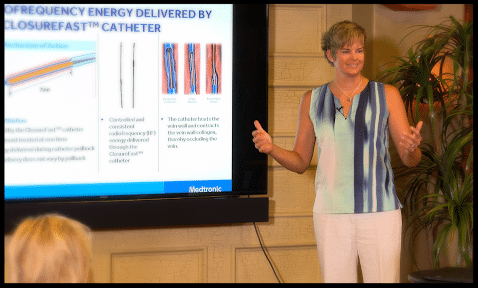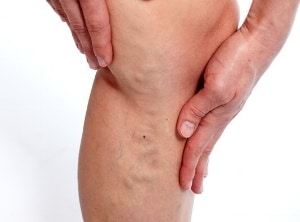How painful is Varicose Vein Treatment?
In the second of this educational video series, Jilanne Rose talks about the pain involved in various Varicose Vein Treatments. In some cases it's negligible!
Transcript
The ease with which we can eliminate varicose veins depends solely on what type of underlying problems you have. That question can’t be easily answered until after a thorough evaluation including an ultrasound. The discomfort that comes along with treatments for varicose veins varies with the type of treatment that you have.
1) With sclerotherapy, which is the least invasive type of vein treatment that is used to treat smaller veins that are closer to the surface of the skin, the discomfort is only with the treatment and that involves injecting them with a solution that causes them to close off permanently. The discomfort is with the needle puncture and you have some slight itching similar to a mosquito bite for about an hour afterwards. Then you don’t have any discomfort with that treatment after that.
2) With a VenaSeal, which is the newest FDA approved procedure, it uses an adhesive to close the larger veins off. With that treatment you have the discomfort with the treatment itself. I have found after doing several of them, most patients do not have any discomfort post procedure, even a few hours after or a few days after.
3) The final treatment is thermal ablation and that uses heat energy to close the veins off from the inside. There are both lasers and radiofrequency closures. With those treatments the discomfort with the procedure comes in the fact that we surround these veins with numbing medicine in order to prevent you from feeling the discomfort of this type of energy. The numbing medicine lasts about four hours and as it wears off most people are stiff and sore for several days afterwards. The best thing you can do for that discomfort is to stay active. The more you are up and moving the less discomfort you will have.
Is there anything worse than itchy varicose veins? Maybe, but itchy veins remains high on the list of issues we would love to resolve before they drive us crazy. If you are experiencing itching around your varicose veins, it could be a message from your body that it is time to have your veins checked…
Read MoreThe full story on Chronic Venous Insufficiency, what it is and how to treat it. A video presentation by Jilanne Rose, DNP-C, Clinical Director. Run Time 24:46. TRANSCRIPT What’s the Difference Between Veins and Arteries? When we talk about vascular health and vascular disease most people think about arteries. When we talk about the…
Read MoreA group of Gilbert Arizona Residents concerned about Chronic Venous Insufficiency gathered on Saturday July 16th for an interactive discussion on CVI symptoms, causes and treatments. Chronic Venous Insufficiency, Venous Reflux Disease and Varicose Veins affect over 30 million American men and women. Unfortunately, many do not get treated as they believe varicose veins are…
Read MoreCan Chronic Venous Insufficiency (CVI) be reversed? Unfortunately the short answer to this question is no; but CVI can be treated with minimally invasive procedures which can reduce symptoms and improve quality of life tremendously! Chronic Vein Insufficiency Causes In order to understand why venous insufficiency or peripheral venous insufficiency cannot be reversed, we must…
Read MoreWhat can you do to treat bleeding varicose vein and spider veins? First and foremost, don’t panic. Although the visual effect of a ruptured varicose vein or bleeding vein can be alarming, there are some simple things that can be done to get the bleeding to stop. If you can reach the area that is…
Read MoreWhy are varicose veins painful? The discomfort associated with varicose veins is caused by a combination of factors. When veins are weak, the blood which is supposed to return to the heart in a timely fashion, settles and pools in the superficial vein system. This pooling of blood worsens when patients stand or sit in…
Read MoreEndovenous Ablation Definition Taken literally, endovenous ablation is the removal of a vein from within. ‘Endo’ means internal or inside, ‘venous’ refers to a vein, and ablation is to ‘remove’. In the instance of veins, it is no longer necessary to physically remove a vein from the leg (vein stripping) to improve symptoms or the…
Read MoreThe newest procedure for the treatment of varicose veins was approved by the FDA about two years ago. It is what has been termed a non-tumescent non-thermal therapy. What this means is that it does not require a lot of numbing medicine to complete, and it does not use a heating element to close or…
Read MoreWhat is the best treatment for varicose veins? No varicose vein is the same; no person’s symptoms are the same; and so the best procedure for varicose veins is not always the same. The treatments associated with vein disease are based on a patient’s symptoms, vein size, location, contributing conditions, and ultrasound findings. Different…
Read More

